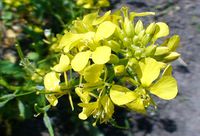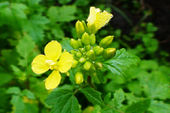Difference between revisions of "Mustard"
| Line 13: | Line 13: | ||
<gallery caption="" widths="170px" heights="120px" perrow="4"> | <gallery caption="" widths="170px" heights="120px" perrow="4"> | ||
File:Frozen mustard flower.jpg|I use mustard in various ways. When the plants are young i cook them as spinach or eat them as salad. Later i use the flowers to mix through green salad. The mustard seeds can be made into mustard sauce by adding vinegar. In the garden, mustard is an excellent green manure. It grows so quickly that it outgrows weeds. It gives lots of material for mulching or compost. It can be sown even in late summer. The plants shown in the picture have not been affected by the light frost, but mustard does not survive stronger frost. | File:Frozen mustard flower.jpg|I use mustard in various ways. When the plants are young i cook them as spinach or eat them as salad. Later i use the flowers to mix through green salad. The mustard seeds can be made into mustard sauce by adding vinegar. In the garden, mustard is an excellent green manure. It grows so quickly that it outgrows weeds. It gives lots of material for mulching or compost. It can be sown even in late summer. The plants shown in the picture have not been affected by the light frost, but mustard does not survive stronger frost. | ||
| + | File:Mustard flower with water drops.jpg|Mustard flower in morning dew | ||
</gallery> | </gallery> | ||
Revision as of 07:00, 25 December 2011
External links
- Mustard plant Wikipedia
Chunks of information
A Modern Herbal, by Mrs. M. Grieve (written in the early 19th century): "The young seedling plants of White Mustard are commonly raised in gardens for salad, the seeds being usually sown with those of the garden cress and germinating with great rapidity. They may be grown all the year round, the seed readily vegetating under a hand-glass even in cold weather, if the ground is not absolutely frozen." And: "As green manure, both kinds of Mustard are employed, but the White Mustard is preferred for this purpose by English farmers, the seed being sown in August and September, and when the plants have attained a good size, about two months after sowing, they are ploughed in. Besides affording useful manure in itself, this green manure helps to prevent the waste of nitrates, which instead of being washed away in drainage water, which would probably happen if the soil were bare, are stored up in the growing plant."
Gallery
I use mustard in various ways. When the plants are young i cook them as spinach or eat them as salad. Later i use the flowers to mix through green salad. The mustard seeds can be made into mustard sauce by adding vinegar. In the garden, mustard is an excellent green manure. It grows so quickly that it outgrows weeds. It gives lots of material for mulching or compost. It can be sown even in late summer. The plants shown in the picture have not been affected by the light frost, but mustard does not survive stronger frost.



